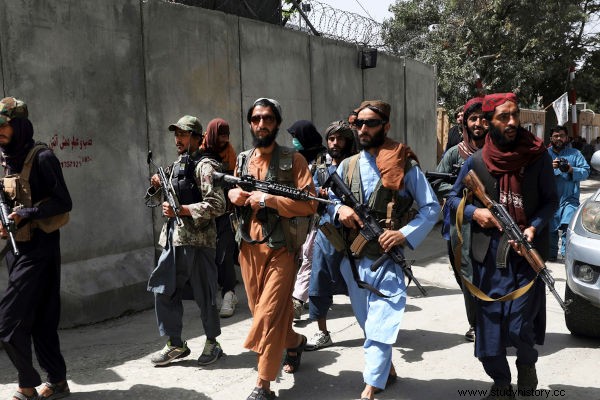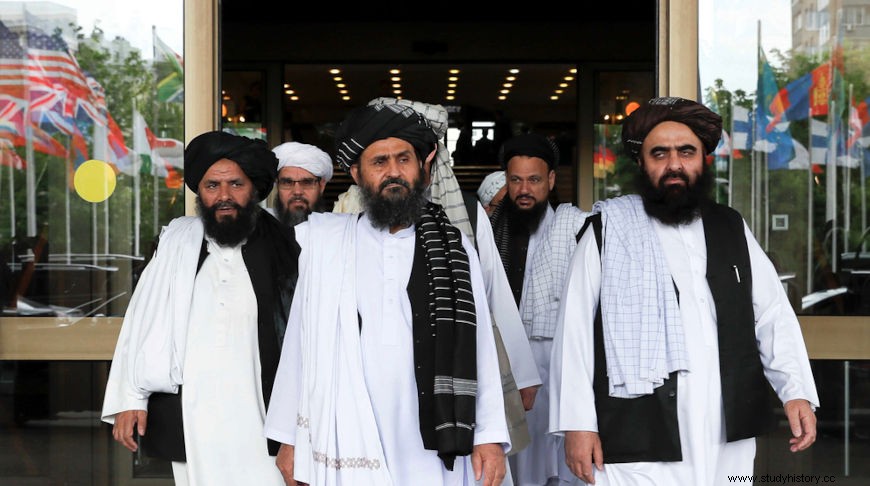
The Taliban , Sunni Islamic fundamentalist group, returned to power in Afghanistan in August 2021, after reconquering virtually all of Afghan territory. This happened with the withdrawal of US troops from Afghanistan, after almost 20 years of occupation. The return of the Taliban is seen as a major threat to the well-being of the Afghan population.
Login also :Gulf War and the US fight against Saddam Hussein
Summary on the Taliban and their return to power in Afghanistan
- On August 15, 2021, the Taliban conquered Kabul, marking the group's return to power in Afghanistan.
- The return of the Taliban to power in Afghanistan was the result of the withdrawal of US troops from that country.
- There is great fear that the Taliban will persecute people who collaborated with the Americans, as well as ethnic and religious minorities and women.
- The Taliban ruled Afghanistan from 1996 to 2001, being overthrown after the country was invaded by US troops in 2001.
Video lesson on the Taliban and the resumption of power in Afghanistan
Taliban return to power in Afghanistan
On August 15, 2021 , the world became aware that the Taliban, an Islamic fundamentalist group, had returned to power in Afghanistan. This was 20 years after they were overthrown by the US-led expedition that invaded the country in 2001.
The Taliban returned to power in Afghanistan, officially speaking, after having conquered the country's capital , Kabul. This was the conclusion of a military offensive that started in August 2021 and that had devastating effects, as, in practically two weeks of attack, the group conquered all the major Afghan provinces and the country's capital.
This was aconsequence of the withdrawal of US troops from Afghanistan after nearly 20 years of occupation. The withdrawal of troops has been considered by US governments since Barack Obama, and during the presidency of Donald Trump, there were even negotiations with the leaders of the extremist group for the Americans to leave the country.
The departure of US troops is explained by the long duration of this conflict , for the high expenses that the war causes and for its low popularity currently in the population of the United States. The long duration of the war demonstrated the US inability to rebuild Afghanistan.
In addition, the high costs of the conflict, which have already exceeded two trillion dollars, explain the US desire to withdraw its troops from the country. President Joe Biden decided it was time for the military to leave. International analysts predicted that this would pose risks to Afghanistan.
The big issue is that US officials did not expect the Taliban to take back Afghanistan so easily, and the big shock came because the group conquered all of Afghanistan in less two weeks, in addition to the country's capital having been conquered without none resistance . Many wondered why the Taliban had such an ease in reconquering Afghanistan, and international analysts raised the following hypotheses:
- The Afghan army was left without air support with the withdrawal of the Americans;
- The demoralization of Afghan troops;
- The Afghan government was weak and did not motivate the troops to fight;
- Corruption in the Afghan government and army.
In this scenario of chaos and accelerating defeats, the president of Afghanistan Ashraf Ghani fled the country and is in exile in the United Arab Emirates. He was also accused of fleeing Afghanistan with US$169 million, an unproven charge. Afghan Vice President Amrullah Saleh has gone into hiding in the only area still resisting Afghanistan, the Panjshir Valley.
Login also :Universal Declaration of Human Rights – understand its importance
What will Afghanistan's future look like?

Taliban return to power in Afghanistan after 20 years has not been viewed positively, either by the international community or by the majority of the Afghan population. His arrival in Kabul took thousands of people to the city's airport in a desperate quest to flee from the country. These people fear the fundamentalists' history of violence.
Since the Taliban arrived in Kabul, some 37,000 people have fled the country with the help of US troops who are still controlling the city's airport. The Taliban, in turn, set August 31 as the last day on which such operations would be allowed.
The biggest fear about the Taliban is that Afghanistan will be governed in the same way as it was between 1996 and 2001, when the group was in power. The Taliban was scarred by human rights violations, and during his rule, executions of opponents were common, as well as torture, amputations and floggings of people.
There is a strong fear that ethnic minorities and religious minorities will be persecuted in the country . Furthermore, Afghan women are a group that has much to fear from the return of these radicals, precisely because they have become known for preventing them from working, studying and walking alone on the streets. They also imposed the use of the burqa.
An international personality who suffered the Taliban's violence against women was Pakistani activist Malala Yousafzai , victim and survivor of an attack carried out by the group against her in 2012. She lived in the Swat Valley, a region of Pakistan occupied by the Taliban at the time.
The fundamentalist group announced that it would grant its government general amnesty and that it would not persecute Afghans who have worked with foreigners for the past 20 years. In addition, they ensured that they would allow women to study and work in the country, but within the limits of Islamic law. Despite the message, the group's actions followed another direction.
Up until then, the Taliban announced that the country would be called Islamic Emirate of Afghanistan (the same name as the period from 1996 to 2001), in addition, he announced that the country will not be a democracy and acted in accordance with what is expected of the group.
Thus, there are records of women who were banned from continuing to work , there were cases of religious minorities being massacred and Taliban critics being executed . In addition, the Taliban violently repressed peaceful demonstrations that took place in the country, and news arrived that the group persecuted people who cooperated with foreigners.
Login also :Syrian Civil War, conflict spanning over 10 years
How did the Taliban come to be?
To understand what the Taliban is and its weight in the recent history of Afghanistan, we need to go back a few years in the history of this Asian country. The Taliban emerged from within the mujahidin , who fought each other for power in Afghanistan between 1992 and 1996, in what became known as the War Civil Afghan .
The mujahidin were rebels that emerged in Afghanistan in the late 1970s with support from Pakistan, the United States and Saudi Arabia. The mujahidin were trained and armed to fight against the socialist government of Afghanistan and to resist the Soviets, who invaded the country in 1979.
After the Soviets abandoned Afghanistan in 1989, the mujahideen fought to overthrow the socialists, which happened in 1992. After that, the dispute was between the mujahidin themselves. , as there were many differences of interests among the Afghan rebels. In this conflict, a portion of them had conservative and fundamentalist ideals.
These ideals contributed to the emergence of the Taliban in 1994. This militia established itself as Afghanistan's main military force and conquered much of the country's territory. Between 1996 and 2001, the Taliban ruled the Islamic Emirate of Afghanistan, and during that period, only the north of the country resisted fundamentalist rule.
It was an authoritarian government and, as mentioned, marked by human rights violations. The Taliban advocate imposing their interpretation radical da Law Islamic , the Shariah . The Taliban persecuted ethnic and religious minorities, as well as women and Muslims who did not abide by the five pillars of the Islamic faith.
The group was toppled from power in 2001, when US-led forces invaded Afghanistan and carried out a military campaign that, together with the Northern Alliance (Afghan resistance to the Taliban), managed to conquer the country. This invasion was a consequence of the attacks of September 11, 2001, coordinated by Al-Qaeda .
Al-Qaeda had military bases in Afghanistan, and its leader, Osama bin Laden , was hiding in Afghan territory. The Taliban gave freedom for al-Qaeda to operate in the country. The United States demanded the expulsion of al-Qaeda and the arrest of bin Laden. As the Taliban refused to respond to them, the Americans organized their invasion of the country.
Despite being defeated and weakened in 2001, the Taliban never ceased to exist. Members of this fundamentalist group have spread to parts of the interior of Afghanistan and Pakistan and financed themselves in a variety of ways. In recent years, they underwent a strengthening that allowed their return to Afghan power.
Image credits
[1] john smith 2021 and Shutterstock
